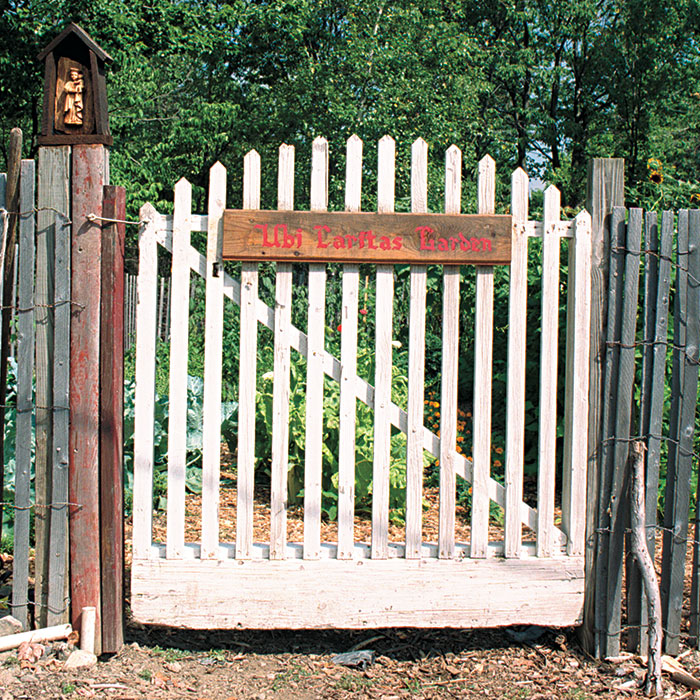
Several years ago, a young man who from time to time makes retreats at our monastery went off to France to spend the summer months. While there, he visited some French monasteries. When he returned home, I asked him if anything had particularly impressed him about the monasteries. He quickly told me it was the monastery gardens cultivated and lovingly cared for by the monks and nuns. “There is real life in those gardens,” he told me. “You can almost feel the pulse of the monks’ life by the work you see accomplished in their gardens.” This commentary made me stop and reflect on the history, the purpose, and the importance attached to gardens in the daily life of a monastery.
Gardening for the soul
In most monasteries, garden work is revered as sacred. Throughout the ages, monks and nuns have held fast to the biblical story that God “took the first man and settled him in the Garden of Eden to cultivate and take care of it.” From the very beginnings of monastic life in the Egyptian desert, garden work was acknowledged as part of God’s command to care for the earth. The lives and writings of those early monks and nuns are full of stories showing them to be efficient and avid gardeners. Since their gardens had to be cultivated under difficult circumstances on desert soil, the monks patiently and with great wisdom went about elaborating the principles of monastic gardening, principles that would be followed by monks for centuries to come. Today, it is well accepted that monastic gardening is as ancient as monastic life itself.
Monks have always taken seriously the Biblical admonition that one must eat from the labor of one’s hands. In practice, this means monks must work hard cultivating their vegetables and herb gardens, and caring for their orchards, always mindful that they must produce sufficient food for the monastic table. And since the monastic diet according to the Rule of Saint Benedict is a vegetarian one for ascetic reasons, the cultivation of vegetables is vitally important in the daily life of the monastic community.

These days, not every monastery is self-sufficient, although most do have gardens. We do what we’re able to do, given our location. For example, at our monastery we don’t have an orchard, partly because our soil is so very rocky, but also partly because our monastery is quite small.
Besides the utilitarian aspect, monastery gardens have always been held in high esteem for a spiritual reason. According to the Scriptures, when God created the world, He walked and conversed with Adam and Eve in the Garden of Paradise. Ever since the fall from grace, we have tried to return to the experience of Paradise by creating gardens all around us. This idea is especially appealing to monks because it coincides with the very purpose of monastic life, which is to live in communion with God. The garden thus becomes for us a sacred place, a haven where we can encounter God. In the evening, after singing Vespers, I often walk and quietly meditate in the garden. The work has stopped, and for a moment I can enjoy that unique presence that fills the entire garden.

Creating an earthly paradise
Proper gardening in a monastery is both a task and an art. It relies on the solid experience and traditions handed over by the monastic gardeners who preceded us. Our techniques are probably not much different from those of good gardeners everywhere. I learned from the older monks to try as much as possible to place the garden so it would have a southern exposure. Good soil preparation and especially good drainage are important. We plant lots of marigolds and aromatic herbs among our vegetables to repel insects. We rotate the vegetables every year. We attach great importance to thorough weeding when the garden is first planted each year. What remains of this tedious task can then be accomplished in a few hours of weekly labor—but how important it is not to miss those hours! We mulch with wood chips or hay to minimize weeds and to keep the soil cool and moist. Working with the proper tools and caring for them correctly is also stressed, and has been for centuries. St. Benedict himself wrote in the Rule that the tools of the garden should be treated with the same respect shown to the sacred vessels of the altar.
Our first garden on this property was planted in 1978, the year our small monastery was established here in New York’s Hudson Valley. We had some hard times at the beginning because of the poor quality of the soil; it is little else but stones. The garden site was problematic—we put it too far away from our buildings. Our location is very rural, and the property is hilly and covered with woods, so the garden was easily accessible to deer, raccoons, and other animals. And we were overly ambitious, making a garden too large for our needs. After a first year of poor harvesting, we moved the garden closer to the monastery building, right next to the barn occupied by our flock of sheep. This discouraged the deer, who usually don’t like to come too close to our quarters, and it also facilitated the transportation of sheep manure to the garden. Furthermore, it gave the garden some protection from heavy winds.

Our garden is 100 percent organic. We maintain its fertility with manure from our sheep and chickens, and with the compost we continue to build each year. This is a never-ending task, for the native soil, as I mentioned before, is poor and rocky. Our first root crops were small and misshapen for not being able to grow deep. In the early days we didn’t even try to grow potatoes. With tenacity and patience we persevered, and have since made notable improvements in the soil, removing as many rocks as possible (many of which were used to build our chapel).
The garden is divided into two equal sections. One side has long raised beds where we cultivate salad and root vegetables, spinach, sorrel, peas, leeks, onions, shallots, flowers, and some herbs. In the other half we grow on level ground those vegetable plants that are larger and thus demand more space—squashes, pumpkins, cucumbers, tomatoes, eggplants, peppers, pole beans, string beans, Swiss chard, cabbages, broccoli, Brussels sprouts, and cauliflower. Also on level ground we plant a variety of potatoes. In the very center of the garden stands a statue of St. Fiacre, a monk and the patron saint of gardeners. The statue is surrounded by pots of flowers, and his protection over the garden is beseeched daily.

There are two small patches built into equal squares, one in front of the statue and the other in the back. These special patches are dedicated exclusively to the cultivation of herbs for the kitchen: various varieties of basil, plus parsley, thyme, oregano, cilantro, sage, dill, rosemary, and garlic. We have another herb garden at the monastery that we use for drying and for ornament, but the one in the vegetable garden is exclusively for fresh kitchen use.
To everything, a season
The monk’s life is ordered and deeply affected by the rhythm of the year. Our daily schedule, our work, our worship all change according to the cycle of the seasons. The stewardship of the monastic land and the care of our gardens get their daily inspiration from the celebration of the Liturgy. Living in harmony with the seasons helps us as gardeners. We stay attuned to such things as the influence of the local weather on planting, the proper nurturing of the soil, knowing the right moment for planting, understanding what is needed for proper growth, and finally, knowing when to harvest. One of the principles we follow is to synchronize our planting schedule with the rhythms of the church year. The seasons of Mother Nature and of Mother Church blend wonderfully in our daily experience. Lent and Easter, for example, are times of spiritual rebirth. They happen at a time of year when the garden is reborn as well.
The monastic table is also seasonal. Naturally, the garden has been the main source of inspiration for my cooking. Besides being seasonal and vegetarian, my cooking is firmly rooted in the French traditional cooking with which I was raised. It emphasizes balanced nutrition and good flavor, achieved with a certain frugality and simplicity which are typical of monasteries.

We can and freeze a lot of our vegetables and fruits; some we store in cool cellars; for others we extend the growing season as long as we can. Because the last couple of winters have been rather benign and because we covered the vegetables on cold nights, we have been able to extend the harvest of hardy vegetables such as leeks, Brussels sprouts, cabbage, Swiss chard, beets, turnips, carrots, and salad greens until the end of the year. We always make a point of feasting on Thanksgiving, Christmas, and New Year’s Day with what is still available fresh in the garden.
After that, the garden is put to rest until the next growing season. The land needs a reprieve, as does the monk gardener. In the winter we rejoice and give thanks for what the garden has provided for our daily sustenance. During those months, when I open a jar of sauce from our own tomatoes, onions, and basil, I can distinctly recollect the original aromas from the garden. The same is true when we use our frozen spinach, chard, beans, or our canned beets or carrots, or our pickled cucumbers, or the winter squash and potatoes, which have been carefully kept in the cool cellar.
The bounty of a vegetable garden does not end at the time of the harvest; it continues yielding long beyond the appointed time. It remains for the cook to use talent, imagination, and good taste to create dishes that can be savored and enjoyed long after the garden has been allotted its well-deserved rest.
—Brother Victor-Antoine d’ Avila-Latourrette gardens at Our Lady of the Resurrection Monastery in LaCrangeville, New York, and is the author of several cookbooks, including Fresh From a Monastery Garden (Doubleday).
Photos: Mark Vassallo.
December 2000
from Kitchen Gardening #30
Fine Gardening Recommended Products

Gardena 3103 Combisystem 12-Inch To 20-Inch Adjustable Metal Fan Rake Head
Fine Gardening receives a commission for items purchased through links on this site, including Amazon Associates and other affiliate advertising programs.

A.M. Leonard Deluxe Soil Knife & Leather Sheath Combo
Fine Gardening receives a commission for items purchased through links on this site, including Amazon Associates and other affiliate advertising programs.

Corona E-Grip Trowel
Fine Gardening receives a commission for items purchased through links on this site, including Amazon Associates and other affiliate advertising programs.



















Comments
Log in or create an account to post a comment.
Sign up Log in